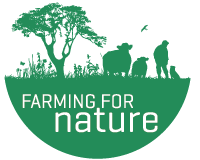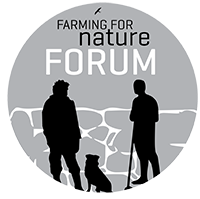DAIRY
Here are some practical ways to take climate action and enhance biodiversity on your dairy farm
Climate & Biodiversity actions full doc (pdf)
Dairy section only (pdf)
Whilst every farm is different, every farm has something to offer to help mitigate climate change and help nature thrive, cleaner waters and improve soil biology on your land. The following are tips from other farmers compiled to help you find simple ways to improve upon these areas on your farm.
“In my opinion we as farmers can help sequester carbon and help nature by letting our hedges mature and taking it a little easier on the land. We have to accept that we cannot have our farms totally manicured all the time if we want to help nature. If we want to help nature and the planet we have to change how we farm. If we keep doing the same thing we will keep getting the same result” Sean Condon, Dairy farmer & FFN Ambassador, Co. Limerick
1. Nutrient & pasture management
Slurry and fertilisers release harmful greenhouse gases.
The manufacture of chemical fertilisers generates ~1.4% of all carbon dioxide emissions and the application of both slurry and fertilisers releases nitrous oxide, a gas with 300 times the global warming potential of carbon dioxide. A nutrient management plan can help you to reduce your use of these inputs by improving their efficiency.
- Treat your slurry with respect! – slurry is an increasingly valuable farm asset, don’t waste it
- Retain, enhance and create buffer strips and hedgerows to help prevent nutrient run-off
- Maximise nutrient uptake by crops by maintaining optimum soil pH
- Measure grass to identify fields that don’t need fertilising
- There is a slurry storage deficit on ~40% of Irish farms. Could a slight reduction in stocking rate take the pressure off in terms of slurry storage?
- Where possible, use low emissions slurry spreading
- To maximise nutrient absorption, spread fertiliser, slurry and farmyard manure on warmer days (soil temp at least 6°C) and don’t spread slurry out of season!
- Include nitrogen fixing legumes in swards or feed crops (e.g. clover, vetch, beans)
- Switch to using protected urea (rather than CAN)
- Try simple mobile phone operated GPSs and tractor sensors to maximise nutrient uptake through more targeted spreading
- Improve drainage, drought tolerance and animal performance by planting species-rich (multispecies) swards
- Enhance or retain sward diversity by reducing grassland management intensity (reduce the use of chemical inputs) and avoid reseeding old permanent pasture
- Maintain clover in the sward to increase dry matter production, improve milk yields and naturally fix nitrogen. Remember – chemical nitrogen inhibits the growth of clover
Co-benefits for farmers
- Decreased fertiliser use (lower costs)
- Increased farm self-sufficiency (lower external inputs)
- Decreased vulnerability to market forces (greater resilience)
2. Soil
“We soil sample every two years. This gives us a better idea of soil fertility, and allows us to make better decisions on what we can apply to the land.” Gearoid Maher, Dairy farmer & FFN Ambassador, Co. Limerick.
Healthy soils store carbon. Reduce inputs and prolong the grazing season by caring for your soil – it’s your greatest asset!
- Keep your soil aerated by avoiding poaching and compaction by heavy machinery.
- Increase soil carbon and the population of earthworms, microbes and mycelia (naturally occurring fungal hyphae that boost soil fertility) by minimising inversion ploughing (e.g. when reseeding) and the use of chemical inputs.
- Protect your soils from erosion – don’t leave soil uncovered, particularly over winter.
- Naturally fix nitrogen and improve drainage and drought tolerance by planting species-rich swards
- Allow sward diversity to develop naturally by reducing grassland management intensity (reduce fertilising/spraying) and avoiding overgrazing (particular in May/June when meadows are flowering).
- Retain maximum soil carbon by minimising ploughing and reseeds
- Maximise the grazing season to minimise the need for imported feed – feed and silage production makes up 14% of emissions from the dairy sector and our use of soya based feeds is contributing to rapid destruction of the rainforest in Brazil
Co-benefits for farmers
Healthy soil:
- increases yields
- has a higher level of available nutrients for forage crops (meaning less fertilizer is used)
- is easier to cultivate (meaning less diesel is used)
- retains more moisture (making crops more drought tolerant)
- drains better (making land more flood resistant)
- supports more soil microbes (which in turn store more carbon and lead to even healthier soils)
3. Trees, scrub & hedgerows
Woody vegetation captures and stores carbon.
- Retain, enhance or create woodland areas, copses and scrubland
- Allow for natural regeneration of trees and scrub in less productive areas
- Plant native hedgerows
- Allow existing hedgerows to grow both tall and wide
- Experiment with agroforestry/silvopasture to build a climate resilient farm system
- Diversify farm enterprises by planting a native woodland (or better yet, allow one to naturally regenerate!)
Co-benefits for farmers
In a dairy farming system woody vegetation can:
- provide diverse grazing
- provide shade & shelter
- improve animal welfare
- enhance biodiversity
- diversify farm enterprises
“We don’t cut any of our hedgerows as we get no financial return for it, on the flip side of this there is a huge benefit for biodiversity. We plant trees every year as a way of increasing the amount of shelter for livestock.” Gearoid Maher, Dairy farmer & FFN Ambassador, Co. Limerick.
4. Water management
Our water bodies (rivers, lakes and oceans) naturally work together to support biodiversity and to store carbon. When water bodies are polluted, these systems break down. Almost half of Irish surface waters are not in good health and the situation is deteriorating. Help to restore our water bodies by eliminating harmful farm run-off:
- Treat your chemicals with respect – just one drop of pesticide can pollute a small stream for over 30kms!!
- Reduce herbicide use by using alternative methods of weed control e.g. non-synthetic herbicides and diverse crop rotations. As many synthetic herbicides are water soluble (e.g. MCPA, 2,4-D), it is almost impossible to ensure they do not end up in watercourses after application!
- Watch out for leakage from bale or pit storage areas and clean up fallen or waste silage and store with farmyard manure – silage effluent is a potent pollutant!
- Could you list the potential sources of run-off from your farm and how you might eliminate them? Some of these (e.g. slurry, herbicides) are more obvious than others (e.g. spoil from tractor tyres, washings or waste silage)
- To reduce nutrient run-off from pasture: plant buffer strips, field margins and hedgerows to slow the flow of nutrients, and retain, enhance or create wetlands to soak up and filter run-off after heavy rain
- Keep clean run-off (e.g. from shed roofs and clean paved areas) separate from soiled water, parlour washings and slurry
- Spread soiled water in dry fields far from water-courses
- Never spread or spray inputs when rain is due!
- Protect your water bodies from grazing livestock: fence livestock well back from watercourses; don’t allow stock to drink directly from rivers; avoid poaching and pinch points
Co-benefits for farmers
- Reduced input, labour, fuel and machinery costs
- Cleaner water and improved health – research has detected herbicides in 38% of drinking water wells tested in Ireland!!
5. Energy & fuel
Maximise energy efficiency and reduce fossil fuels to minimise your carbon footprint!
- Milk cooling accounts for one third of energy usage on dairy farms while heating water accounts for one fifth! Installing a heat recovery unit on the bulk tank can help address both issues, reducing energy use for cooling milk by 50%.
- Don’t waste heat! Look into a TAMS grant to install a solar thermal system to heat water and ensure your water heater and the first six metres of pipe running from the heater are well insulated.
- Have you looked into renewable energy? A shed roof can be the ideal place to install solar panels for electricity and there are TAMS grants available.
- Use machinery (diesel!) efficiently – check tyre pressure regularly, remove unnecessary tractor weights and don’t let engines run idle.
- Switch to LED lighting and turn off lights when not in use.
- Vacuum pumps account for a fifth of energy usage on dairy farms; variable speed vacuum pumps can reduce this energy usage by 60%.
- Consider using solar water pumps – the technology and cost has greatly improved in recent years.
- Repair any leaky pipes or troughs. Over 43% of treated drinking water in Ireland is lost to leaks!
- Could you harvest rainwater from buildings? Using this ‘grey water’ could save money and energy.
- Minimise the use of chemical fertilisers, herbicides and pesticides – these are all manufactured using fossil fuels
- Can you produce more of your own inputs on farm? For example, growing your own feed crops can reduce emissions from the transport of feed grown elsewhere (e.g. Brazil!)
- Plastics are produced using fossil fuels – choose suppliers that minimise the use of plastic packaging and try to avoid using single-use plastic products around the farm
Co-benefits for farmers
- Reduced fuel and input costs
- Reduced energy costs
- Improved farm self-sufficiency and climate resilience
“We switch(ed) our water heater from electricity to gas and install(ed) a heat recovery unit on the bulk tank, this unit uses the excess heat from the bulk to heat the water to a certain temperature and then gas kicks in to get the water to the required temperature. This system reduces gas consumption by 70%. We are also installing a variable milk speed pump which reduces the electricity demand by 50% at milking” Gearoid Maher, Dairy farmer & FFN Ambassador, Co. Limerick.
Curious? Have you run the numbers for reduced stocking rates or going organic?
Reduced stocking rates: Methane is by far the greatest contributor to emissions in the dairy sector (~65% of all emissions). Eighty-five per cent of this comes from the cow’s rumen, while 15% comes from slurry storage and spreading. Considering the rising costs of fertiliser and slurry storage, coupled with the new direction of farm payments under CAP 2023-27, could it make financial as well as climate sense to start to reduce methane by reducing stocking rates?
Going organic: Have you run the numbers for going organic? New supports and a growing market for organic dairy products are making this an increasingly attractive option for dairy farmers.
If you are running the numbers for reduced stocking rates, don’t forget to factor in reductions in your own labour time!
Nature co-benefits
Dairy farm climate action can benefit nature by creating:
- More species-rich pasture, supporting native fungi, insects, birds, mammals and more!
- Healthier rivers, lakes, estuaries and oceans, rich with life
- Habitat for our native species to feed and breed
- Nature-rich farms – loud with humming insects and singing birds
- A model for other dairy farmers; when we experience nature on another farm we are more likely to want to protect it on our own!
Nothing beats nature for providing natural climate change adaptation and mitigation. Boosting biodiversity, from the soil to the treetops, will help your farming system to remain productive and resilient in the face of increasingly unpredictable weather events.


